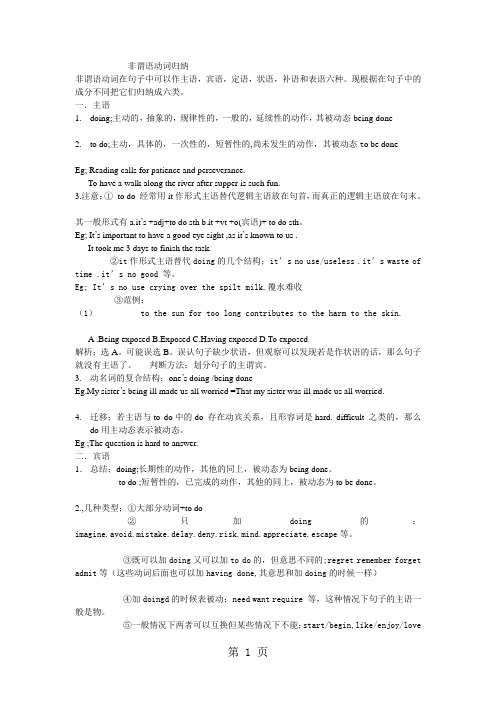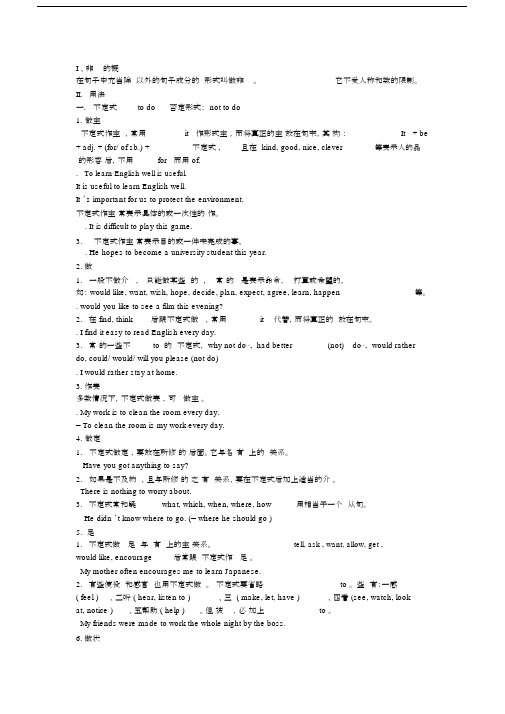九年级英语非谓语动词用法归纳
- 格式:doc
- 大小:54.00 KB
- 文档页数:7

中考重点非谓语动词的形式与用法非谓语动词是指动词的一种形式,不具备时态和人称的变化,也不能作谓语。
在中考英语中,非谓语动词是一个重要的考点,包括不定式、动名词和分词三种形式。
本文将介绍非谓语动词的形式与用法。
一、不定式不定式形式为“to + 动词原形”,不定式在句中可以作主语、宾语、宾语补足语、状语等。
1. 作主语To learn a foreign language is helpful for our future.2. 作宾语I want to visit Beijing next month.3. 作宾语补足语I find it difficult to solve this math problem.4. 作状语He woke up early to catch the first bus.二、动名词动名词具有名词和动词的特点,动名词形式为动词+ing。
动名词在句中可以作主语、宾语、宾语补足语、状语等。
1. 作主语Swimming is my favorite sport.2. 作宾语She enjoys reading books in her free time.3. 作宾语补足语We saw them swimming in the pool.4. 作状语He improved his English by practicing speaking every day.三、分词分词包括现在分词和过去分词。
现在分词形式为动词+ing,过去分词形式有规则和不规则两种。
1. 现在分词作定语The running water is very clear.2. 过去分词作定语The broken computer needs to be repaired.3. 过去分词作表语I am interested in the stories told by the old man.4. 现在分词/过去分词作状语Feeling tired, he decided to take a rest.四、非谓语动词的用法1. 不定式用于表示目的、结果、原因、方式等。

初中英语语法 非谓语动词总结非谓语动词主要包括不定式、非谓语动词主要包括不定式、动名词和现在分词。
动名词和现在分词。
为了区分这三种不同的非谓语动词的用法和含义,动词的用法和含义,我们将分别从三种非谓语动词在句子中做主语、我们将分别从三种非谓语动词在句子中做主语、我们将分别从三种非谓语动词在句子中做主语、宾语、宾语、宾语、宾语宾语补足语、补足语、定语、定语、定语、状语、状语、状语、表语以及一些特殊结构句型等角度来区分其用法和细微含表语以及一些特殊结构句型等角度来区分其用法和细微含义。
义。
1.不定式和动名词作主语的区别.不定式和动名词作主语的区别(1)动名词作主语通常表示抽象动作;而不定式作主语表示具体动作。
Smoking is prohibited(禁止禁止)here .这里禁止抽烟。
(抽象) It is not very good for you to smoke so much .你抽这么多烟对你身体很不好。
(具体) (2)动名词作主语时,通常用以表示一件已知的事或经验。
不定式短语通常用来表示一件未完成的事或目的。
Climbing mountains is interesting .爬山很有趣。
(经验) Driving a car during the rush hour is tiring .在高峰时刻开车令人厌烦。
(经验) (3)不定式做主语,一般用it 当形式主语,把作主语的不定式短语后置。
It took me only five minutes to finish the job. 2.不定式、动名词和分词作表语的区别(1)不定式作表语不定式作表语1)不定式作表语一般表示具体动作,特别是表示将来的动作。
To do two things at a time is to do neither .--次做两件事等于未做。
次做两件事等于未做。
What I would suggest is to start work at once.我的建议是立刻开始干。

初中英语语法公式非谓语动词
非谓语动词是指在句子中不表示谓语关系,可作主语、宾语、定语、
状语等的动词形式。
在初中英语语法中,常见的非谓语动词有动词不定式、动名词和分词。
1.动词不定式
a. 主动形式:to + 动词原形(to do)
b. 被动形式:to be + 动词过去分词(to be done)
c. 完成形式:to have + 动词过去分词(to have done)
2.动名词
动名词的形式为动词 + -ing(doing)
3.分词
a. 现在分词:动词原形 + -ing(doing)
b. 过去分词:动词过去式或不规则过去分词形式(done)
非谓语动词在句子中具有以下用法:
1. 作主语:To travel is his dream.(不定式)
2. 作宾语:I like swimming.(动名词) / She wants to join
the club.(不定式)
3. 作定语:The book on the table is mine.(现在分词) / The girl with a red hat is my friend.(分词)。

非谓语动词归纳非谓语动词在句子中可以作主语,宾语,定语,状语,补语和表语六种。
现根据在句子中的成分不同把它们归纳成六类。
一.主语1.doing;主动的,抽象的,规律性的,一般的,延续性的动作,其被动态being done2.to do;主动,具体的,一次性的,短暂性的,尚未发生的动作,其被动态t o be doneEg; Reading calls for patience and perseverance.To have a walk along the river after supper is such fun.3.注意;①to do 经常用it作形式主语替代逻辑主语放在句首,而真正的逻辑主语放在句末。
其一般形式有a.it’s +adj+to do sth b.it +vt +o(宾语)+ to do sth。
Eg; It’s important to have a good eye sight ,as it’s known to us .It took me 3 days to finish the task.②it作形式主语替代doing的几个结构;it’s no use/useless .it’s waste of time .it’s no good 等。
Eg; It’s no use crying over the spilt milk.覆水难收③范例;(1) to the sun for too long contributes to the harm to the skin.A .Being exposed B.Exposed C.Having exposed D.To exposed解析;选A。
可能误选B。
误认句子缺少状语,但观察可以发现若是作状语的话,那么句子就没有主语了。
判断方法;划分句子的主谓宾。
3.动名词的复合结构;one’s doing /being doneEg.My sister’s being ill made us all worried =That my sister was ill made us all worried.4.迁移;若主语与to do中的do 存在动宾关系,且形容词是hard. difficult 之类的,那么do用主动态表示被动态。

I、非的概在句子中充当除以外的句子成分的形式叫做非。
它不受人称和数的限制。
II.用法一. 不定式to do否定形式:not to do1. 做主不定式作主,常用it作形式主,而将真正的主放在句末,其构:It + be + adj. + (for/ of sb.) +不定式,且在kind, good, nice, clever等表示人的品的形容后,不用for而用of..To learn English well is useful.It is useful to learn English well.It ’s important for us to protect the environment.不定式作主常表示具体的或一次性的作。
. It is difficult to play this game.3.不定式作主常表示目的或一件未完成的事。
. He hopes to become a university student this year.2.做1.一般不做介,只能做某些的,常的是表示命令,打算或希望的,如: would like, want, wish, hope, decide, plan, expect, agree, learn, happen等。
. would you like to see a film this evening?2.在find, think后跟不定式做,常用it代替,而将真正的放在句末。
. I find it easy to read English every day.3.常的一些不to 的不定式, why not do⋯, had better (not) do⋯, would rather do, could/ would/ will you please (not do). I would rather stay at home.3.作表多数情况下,不定式做表,可做主。

中考英语专题:非谓语动词用法详解非谓语动词的含义非谓语动词首先是一种动词形式,其次是这种动词形式不能做谓语,综合这两点,我们将其叫做非谓语动词。
非谓语动词的形式非谓语动词包含四种形式,即不定式、动名词、现在分词和过去分词。
其中,每种形式按照发生时间和主被动又包括不同的子形式。
具体如下:1. 不定式①基本形式:to do(表示主动,并且一般表示将来)②被动式:to be done(表示被动,并且一般表示将来)③进行式:to be doing (表示主动和进行)④完成时:to have done(表示主动和完成)⑤完成被动式:to have been done(表示被动和完成)⑥完成进行式:to have been doing (表示主动和完成进行)The teacher told us to do morning exercises.老师让我们做早操。
The car to be bought is for his sister.要买的这辆车是给他的姐姐的。
She pretended to be reading when the teacher came into the classroom. 老师进来时,她假装正在读书。
The thief is said to have escaped.据说小偷已经逃跑了。
The thief is said to have been arrested.据说小偷已经被抓住了。
She is said to have been working in the factory over the last 20 years.据说在过去的20年里,她一直在这家工厂工作。
2. 动名词①基本形式:doing (表示主动)②被动式:being done(表示被动)③完成式:having done(表示主动和完成)④完成被动式:having been done(表示被动和完成)Travelling in space by ordinary people will be common in the future.在未来,普通人在太空旅行将会是普遍的事情。
初中英语语法非谓语动词总结非谓语动词主要包括不定式、动名词和现在分词。
为了区分这三种不同的非谓语动词的用法和含义,我们将分别从三种非谓语动词在句子中做主语、宾语、宾语补足语、定语、状语、表语以及一些特殊构造句型等角度来区分其用法和细微含义。
1.不定式和动名词作主语的区别(1)动名词作主语通常表示抽象动作;而不定式作主语表示具体动作。
Smokingisprohibited(制止)here.这里制止抽烟。
(抽象)Itisnotverygoodforyoutosmokesomuch.你抽这么多烟对你身体很不好。
(具体)(2)动名词作主语时,通常用以表示一件的事或经历。
不定式短语通常用来表示一件未完成的事或目的。
Climbingmountainsisinteresting.爬山很有趣。
(经历)Drivingacarduringtherushhouristiring.在顶峰时刻开车令人厌烦。
(经历)(3〕不定式做主语,一般用it当形式主语,把作主语的不定式短语后置。
Ittookmeonlyfiveminutestofinishthejob.2.不定式、动名词和分词作表语的区别(1)不定式作表语1)不定式作表语一般表示具体动作,特别是表示将来的动作。
Todotwothingsatatimeistodoneither.--次做两件事等于未做。
WhatIwouldsuggestistostartworkatonce我.的建议是立刻开场干。
2〕如果主语是不定式〔表示条件〕,表语也是不定式〔表示结果〕。
Toseeistobelieve百.闻不如一见。
Toworkmeanstoearnaliving.工作就是为了生活。
3)如果主语是以aim,duty,hope,idea,happiness,job,plan,problem,purpose,thing,wish等为中心的名词,或以what引导的名词性从句,不定式作表语是对主语起补充说明作用。
英语非谓语动词用法全面归纳非谓语动词的分类非谓语动词在句子中可以担任六种不同的成分,分别是主语、宾语、定语、状语、补语和表语。
下面根据它们在句子中的不同作用进行分类。
1.主语1)doing:表示抽象的、规律性的、延续性的动作,常用于被动语态中的being done。
例如:XXX.(阅读需要耐心和毅力。
)2)to do:表示具体的、一次性的、短暂性的动作,常用于被动语态中的to be done。
例如:To have a walk along the river after supper is such fun.(晚饭后沿着河边散步真是太有趣了。
)3)注意:①to do经常用it作形式主语替代逻辑主语放在句首,而真正的逻辑主语放在句末。
一般形式有:a。
it’s + adj + to do sth;b。
it + vt + o(宾语) + to do sth。
例如:It’s important to have a good eyesight。
as it’s known to us.(拥有良好的视力很重要,这是我们所知道的。
)It took me 3 days to finish the task.(我用了三天时间完成了这个任务。
)②it作形式主语替代doing的几个结构,如:it’s nouse/useless,it’s a waste of time,it’s no good等。
例如:It’XXX.(覆水难收。
)③范例:1)To the sun for too long contributes to the harm to the skin.A。
Being exposedB。
ExposedXXXD。
XXX解析:选A。
有可能误选B,因为可能误认为句子缺少状语,但实际上这个短语作为状语的话,句子就没有主语了。
正确的判断方法是划分句子的主谓宾。
2)动名词的复合结构:one’s doing/being done。
非谓语动词的用法总结非谓语动词是指不具备人称、数和时态等语法特征的动词形式,主要包括动词不定式(to do)、动名词(doing)和分词(done)。
在英语语法中,非谓语动词常常用于多种不同的结构中,具有独特的功能和用法。
本文将对非谓语动词的用法进行总结,并提供相关例句来加深理解。
一、动词不定式动词不定式是非谓语动词的一种形式,一般由to + 动词原形构成。
动词不定式可以作为名词、形容词或副词的补语,也可以在句子中作主语、宾语、表语和宾补等。
以下是动词不定式的几种主要用法:1. 作主语To swim is my favorite activity.2. 作宾语She wants to eat dinner at home.3. 作表语Her dream is to become a doctor.4. 作定语I have a book to read this weekend.5. 作状语He went to the park to play basketball.6. 作宾补We need you to clean the room.二、动名词动名词是非谓语动词的一种形式,一般由动词的现在分词形式(-ing)构成。
动名词可以作为名词的主语、宾语、定语、表语和宾补等。
以下是动名词的几种主要用法:1. 作主语Swimming is good exercise.2. 作宾语I enjoy reading books.3. 作定语We had a thrilling roller coaster ride.4. 作表语His favorite activity is dancing.5. 作宾补She kept the secret by not telling anyone.三、分词分词是非谓语动词的一种形式,一般由动词的过去分词形式(-ed 或不规则形式)或现在分词形式(-ing)构成。
分词可以作为形容词的定语,修饰名词或代词。
初中英语:非谓语动词含义、形式和用法汇总一. 非谓语动词的含义非谓语动词首先是一种动词形式,其次是这种动词形式不能做谓语,综合这两点,我们将其叫做非谓语动词。
二. 非谓语动词的形式非谓语动词包含四种形式,即不定式、动名词、现在分词和过去分词。
具体形式如下:1. 不定式:to do(表示主动,并且一般表示将来)例如:The teacher told us to do morning exercises .老师让我们做早操。
2. 动名词:doing (表示主动)例如:Travelling in space by ordinary people will be common in the future.在未来,普通人在太空旅行将会是普遍的事情。
3. 现在分词:doing (表示主动和进行)例如:He sat there,reading a newspaper.他坐在那里,读着一张报纸。
4. 过去分词:done及物动词的过去分词表示被动或完成;不及物动词的过去分词表示主动或完成。
polluted river 被污染的河流(及物动词pollute和river之间是被动关系,即“河流被污染”)fallen leaves 落叶(不及物动词fall和leaves之间是主动关系,即“叶子落下来”)注意:非谓语动词本身不能表示现在和过去。
非谓语动词表示进行和将来是相对于谓语动作来说的:和谓语动作同时发生表示进行;发生在谓语动作之后表示将来三. 非谓语动词的作用非谓语动词除去不能做谓语之外,其它所有成分都可以做。
具体如下。
1. 不定式:做主语、宾语、表语、定语、状语和补语。
To learn a foreign language is difficult .(作主语)学会一门外语是很难的。
It’s easy to see their aunt.(作真正主语,it做形式主语)很容易见到他们的姑姑。
Tom wanted to have a cup of beer.(作宾语)汤姆想要喝杯啤酒。
九年级英语 非谓语动词用法归纳 一 常用动词不定式的情况 1. 以下动词后常跟不定式作宾语和宾语补足语 want to do sth , agree to do sth , decide, to do sth , plan, to do sth , learn to do sth , hope to do sth , fail, to do sth , choose,to do sth , prepare to do sth ,, promise to do sth ,, happen to do sth , begin to do sth ,, start, to do sth , wish, to do sth , pretend, to do sth , prefer, to do sth , attempt, to do sth , expect to do sth , offer to do sth , try to do sth , would like to do sth permit to do sth ,, advise,to do sth , seem to do sth volunteer to do sth help sb do sth /to do sth allow,(sb) to do sth , ask, (sb) to do sth , tell (sb)to do sth , , show (sb)o do sth , teach (sb)to do sth , invite(sb) to do sth , encourage(sb)to do sth , order (sb)to do sth , refuse(sb)to do sth ,), sb need to do sth / sth need doing/ sth need to be done 2. be + adj(表示人心情的词) + to do sth sb+be +sorry / glad / surprised / pleased / angry / happy / sure /excited/amazed/relaxed/to do sth 3 It’s + adj + to do sth 做某事… It’s easy / hard / important/possible / impossible / interesting / difficult / necessary / boring / relaxing to do sth(adj描述不定式to do sth的特征).. 4 . It’s + adj + of/ for sb to do sth 对某人来说做某事….. It’s easy / hard / important/possible / impossible / interesting / difficult / necessary / boring / relaxing for sb to do sth(adj描述不定式to do sth的特征,性质时常用for sb) It’s good / kind / nice / clever/ rude / patient / polite / foolish / right / wrong of sb to do sth(描述主语人的性质,身份和特征时常用of sb) 5 too „ to do sth too +adj/adv+ to do sth 太…而不能…. 6 .enough to do sth adj/adv+ enough to do sth 足够…能…. 7 . 疑问词+不定式: how ,when , where, what, which +to do sth 8 固定短语后用动词不定式: (do)try one’s best to do sth, make a decision to do sth, used to do sth, be used to do sth, It takes sb some time to do sth, would like to do sth, be willing to do sth, be supposed to do sth, in order to do sth, It’s time to do sth, have to do sth, , It’s one’s turn to do sth. allow sb to do sth sb be allowed to do sth can’t wait to do sth be careful to do sth be able to do sth be afraid to do sth(be afraid of doing sth) have sth to do have time to do sth have nothing/something to do It’s one’s duty to do sth. be sure to do sth can/can’t/could/couldn’t afford to do sth 9. sb/sth +be +adj(easy/difficult….)+to do sth 10. 名词或代词+不定式。不定式to do 放名词或代词后修饰名词或代词 11. 不定式to do 可用来表示目的可放句首句末 , his farther works day and night. 12. the+序数词first/second/third…+名词/代词+to do sth表示第几做… 13 不定式to do 作主语常表示目的或一件未完成的事 二.常用动词ing形式 1 在以下动词后接动词ing形式: consider doing sth finish doing sth enjoy doing sth mind doing sth miss doing sth suggest doing sth practice doing sth feel like doing sth have fun doing sth succeed(in) doing sth keep (on)doing sth keep sb/sth from doing sth stop sb/sth from doing sth be busy doing sth be always doing sth be afraid of doing sth, be terrified of doing sth , can’t help doing sth, be used for doing, what / how about doing sth, think about / of doing sth, look forward to doing sth, have a hard /difficult time doing sth, be against doing sth pay attention to doing sth, end up doing sth, worry about doing sth, be / get used to doing sth, stay up doing sth, thanks for doing sth, spend time (in) doing sth, instead of doing sth, concentrate on doing sth, dream of doing sth hold on to doing sth, make a living (by) doing sth, be interested in doing sth, go on doing sth, put off doing sth, be strict in doing sth, give up doing sth, devote „to doing sth把„献给, get down to doing sth 开始做某事, imagine doing sth have difficulty/ trouble/problem (in) doing sth, be worth doing sth prefer doing sth A to doing sthB there+be(is /are / was /were/will be/mustbe)sb/sth doing sth +地点 表示某地有某人某事某物正在做„ 2. 介词后用ving形式如 in at for of about from with without on after before against while besides except… 3. . go +ving 表示进行某项活动构成的词组 go shopping go swimming go skating go hiking go fishing go walking go boating go bike riding go sightseeing go skateboarding go ice skating 4. do+some/the /one’s+ving do some/the shopping do some/the washing do some/the cooking do some/the /cleaning/ do some/the /cleaning do some/the reading 5. v-ing+n构成名词短语 短语中常用Ving形式 swimming pool, running star, smoking room, working hours, waiting room, dancing hall, reading room living room , dinning room, writing table, ,running water(自来水), listening skill 6. 动词或动词短语作句子的主语用ving形式 is my dream makes you stressed out in bed is 第2/6页 bad for our eyes 7 感官动词后接动词ing形表示动作正在发生 see sb /sth doing sth hear sb /sth doing sth watch sb /sth doing sth feel sb /sth doing sth find sb /sth doing sth notice sb /sth doing sth 8 . No+ving 表示禁止 No swimming No smoking No talking No parking No swimming 三 几组区别 1. hate/ love/ like to do sth. 表示心理或一次性的具体动作 hate/ love/ like doing sth. 表示习惯性动作 2 begin / start to do sth begin / start doing sth. 1)谈及一项长期活动或开始一种习惯时,使用doing. 2)begin, start用进行时时,后面动词用不定式to do I was beginning to get angry。 3)在begin, start 后接know, understand,这类动词时常用不定式to do。I begin to understand him 。 3. 动名词( V-ing形式) 作主语常表示一件已知的事或经验;不定式作主语常表示目的或一件未完成的事。Skating is very interesting.( 经验 ) To become a doctor is my dream 4. forget to do sth.忘记要去做某事(未做)forget doing sth. 忘记做过某事(已做) 5. remember to do sth. 记住去做某事(未做) remember doing sth. 记得做过某事(已做) 6. stop to do sth. 停下来去做另一件事 stop doing sth.停止正在做的事。 7. go on to do sth. 继续做另外一件事 go on doing sth. 继续做没做完的事。 8. try to do sth. 尽力去做某事 try doing sth. 试着去做某事 四 动词原形 1. 使役动词后面接动词原形 let sb do sth have sb do sth make sb do sth 2 . 感官动词后接动词原形表示动作已完成或经常发生 see sb do sth hear sb do sth watch sb do sth feel sb do sth notice sb do sth find sb do sth 3 . 情态动词后使用动词原形;常用情态动词 can can’t could couldn’t should shouldn’t would wouldn’t may might must musn’t